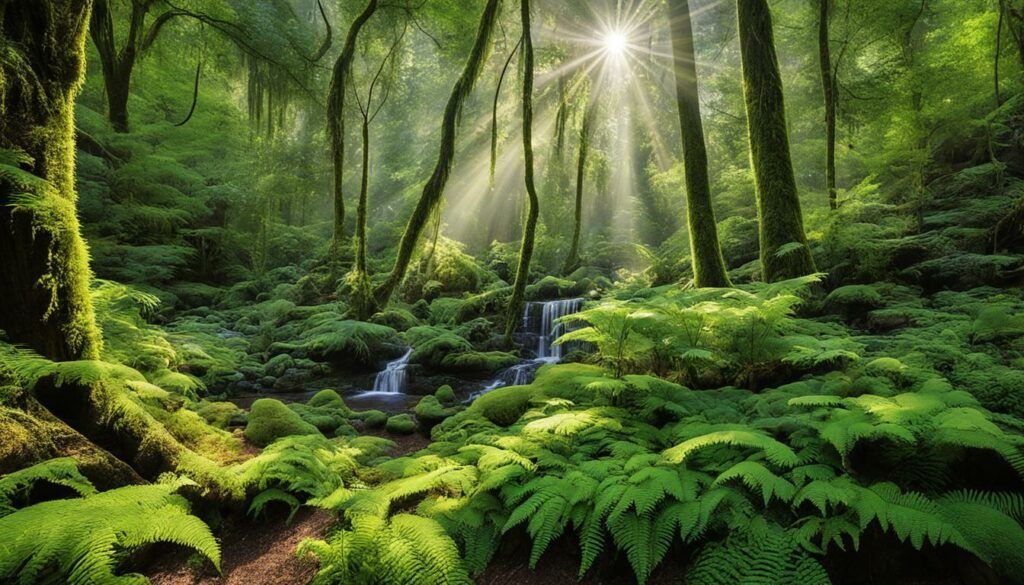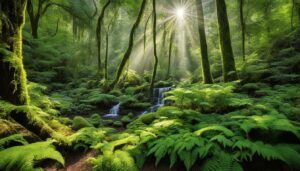“The clearest way into the Universe is through a forest wilderness.” – John Muir
Shade forest plants are nature’s way of creating beauty even in the darkest corners. These plants not only survive but thrive in low-light environments, transforming your garden into a mesmerizing woodland oasis. If you have areas in your garden that receive limited sunlight, shade forest plants are the perfect solution to bring life and tranquility to those spaces.
In this article, we will explore the top varieties of shade forest plants that you can incorporate into your garden. Whether you have a small balcony or a sprawling backyard, these plants will add a touch of natural beauty and serenity to your outdoor space. Let’s dive in and discover the captivating world of shade forest plants.
Key Takeaways
- Shade forest plants thrive in low-light environments and are perfect for shady areas in your garden.
- These plants add beauty, tranquility, and a touch of natural wilderness to your outdoor space.
- By choosing the right shade forest plants, you can create a lush and vibrant woodland oasis.
- Some popular varieties of shade forest plants include hostas, ferns, astilbe, hellebores, and bleeding hearts.
- Shade forest plants are suitable for both experienced and novice gardeners and are easy to grow.
Essential Features of Shade Forest Plants
Shade forest plants possess certain essential features that enable them to thrive in low-light environments. These features play a crucial role in their ability to efficiently photosynthesize and maximize the limited sunlight available to them. Understanding these key features is vital when selecting the right shade forest plants for your garden.
One prominent feature of shade forest plants is their large dark green leaves. These leaves are specifically designed to maximize surface area, allowing them to capture as much sunlight as possible. The larger the leaves, the more sunlight they can absorb, ensuring optimal photosynthesis even in shady areas.
Another important feature of shade forest plants is their adaptability to various soil conditions. These plants are known for their resilience and ability to thrive in different types of soil, making them versatile additions to any garden. Whether your soil is sandy, loamy, or clay-based, shade forest plants can still flourish and add beauty to your shady areas.
Shade forest plants also exhibit a remarkable tolerance to moisture levels. They have the ability to thrive in damp and humid environments, making them suitable for gardens with high levels of shade and moisture. This adaptability ensures that these plants can grow healthily and maintain their vibrant appearance, even in areas that receive minimal sunlight.
Additionally, shade forest plants have evolved to withstand competition from other plants. They possess mechanisms that allow them to efficiently utilize resources and thrive alongside other vegetation. This adaptability to crowded conditions is particularly advantageous in shaded areas where plants often have to compete for limited resources.
By understanding the essential features of shade forest plants, you can make informed decisions when selecting plants for shady areas in your garden. These plants’ ability to maximize sunlight absorption, adapt to various soil conditions, tolerate moisture levels, and withstand competition make them ideal choices for creating a lush and vibrant woodland oasis.
“Shade forest plants possess key features that allow them to thrive in low-light environments, such as their large dark green leaves that maximize sunlight absorption and their adaptability to various soil conditions.”
| Essential Features | Description |
|---|---|
| Large Dark Green Leaves | Maximize sunlight absorption in shady areas |
| Adaptability to Various Soil Conditions | Thrives in different types of soil |
| Tolerance to Moisture Levels | Can thrive in damp and humid environments |
| Ability to Withstand Competition | Efficient resource utilization in crowded conditions |
Shade Forest Plants Perfect for Your Garden
When it comes to creating a beautiful garden in shady areas, selecting the right plants is crucial. Fortunately, there are several shade forest plants that thrive in low-light conditions and add charm to any garden. These plants are not only shade-tolerant but also offer unique features that enhance the aesthetics of your outdoor space. Here are some top varieties of shade forest plants that are perfect for your garden:
Hostas: A Tapestry of Textures and Hues

Hostas are a popular choice for shade gardens due to their wide range of leaf colors, sizes, and textures. These plants create a tapestry of foliage that adds visual interest and depth to your garden. With their lush and vibrant leaves, hostas can transform shady areas into lush, green oases. They are low-maintenance and come in various cultivars, making it easy to find the perfect hosta for your garden.
Ferns: The Timeless Elegance of Lacy Leaves
Ferns have been a part of shade gardens for centuries, thanks to their timeless elegance and delicate lacy leaves. These graceful plants can thrive in the low light of a shade forest, bringing a touch of natural beauty to your garden. With their soft, feathery fronds, ferns create a serene and tranquil atmosphere that’s perfect for relaxation. Some popular fern varieties for shade gardens include maidenhair ferns, ostrich ferns, and Japanese painted ferns.
Astilbe: Vibrant Blossoms and Feathered Foliage
Astilbe is a shade-loving perennial that adds vibrant color and texture to your garden. With its plume-like flowers and finely divided foliage, astilbe brings a touch of elegance and drama to shady areas. These plants come in various shades of pink, red, and white, creating a stunning visual display. Astilbes are also known for their ability to thrive in moist soil, making them perfect for low-light forest environments.
Hellebores: A Flourish of Winter Flowers
Hellebores, also known as Lenten roses, are shade-loving plants that bloom during the winter months. These hardy perennials produce beautiful flowers in an array of colors, including white, pink, and purple. With their evergreen foliage and nodding blossoms, hellebores add a flourish of color and charm to your garden, even in the coldest months. These plants are perfect for creating a winter wonderland in your shade garden.
Bleeding Hearts: Cascades of Romantic Blossoms
Bleeding hearts are iconic shade garden plants that are known for their unique heart-shaped flowers. These romantic blossoms cascade from arching stems, creating a stunning display of color in shady areas. Bleeding hearts come in shades of pink, white, and red, adding a touch of romance and charm to your garden. These easy-to-grow perennials are ideal for adding a whimsical touch to your shade-filled outdoor space.
| Shade Forest Plant | Main Features |
|---|---|
| Hostas | Tapestry of textures and hues |
| Ferns | Timeless elegance of lacy leaves |
| Astilbe | Vibrant blossoms and feathered foliage |
| Hellebores | Flourish of winter flowers |
| Bleeding Hearts | Cascades of romantic blossoms |
Conclusion
Shade forest plants offer a perfect solution for those looking to add beauty and vibrancy to areas in their garden with limited sunlight. These plants thrive in the shade, providing a serene and enchanting woodland oasis. By carefully selecting the right shade-tolerant varieties, such as hostas, ferns, astilbe, hellebores, and bleeding hearts, you can transform your garden into a tranquil retreat filled with captivating colors, textures, and fragrances.
Whether you have a spacious garden or a small balcony, shade forest plants are a versatile choice that can enhance any outdoor space. Their adaptability and unique features allow them to thrive in low-light conditions, making them the ideal choice for shady areas in your garden. With their lush foliage and beautiful blooms, these plants add a touch of natural beauty that will delight you year after year.
Embrace the magic of shade forest plants and bring your garden to life. With their ability to flourish in shade, they offer a captivating display that will enchant both experienced gardeners and beginners alike. So, whether you want to create a peaceful retreat or add a pop of color to your landscape, consider incorporating shade forest plants into your garden and experience the enchantment they bring. Shade forest plants are varieties that are specially adapted to thrive in shady areas that have limited sunlight. They have features that allow them to efficiently photosynthesize and make the most of low-light environments. Shade forest plants have large dark green leaves that maximize their surface area for capturing sunlight. They are adaptable to various soil conditions, tolerate moisture levels, and can withstand competition from other plants. Some of the top varieties of shade forest plants for your garden include hostas, ferns, astilbe, hellebores, and bleeding hearts. These plants not only tolerate shade but also thrive in it, adding beauty and charm to shady areas. FAQ
What are shade forest plants?
What are the essential features of shade forest plants?
Which shade forest plants are perfect for my garden?






